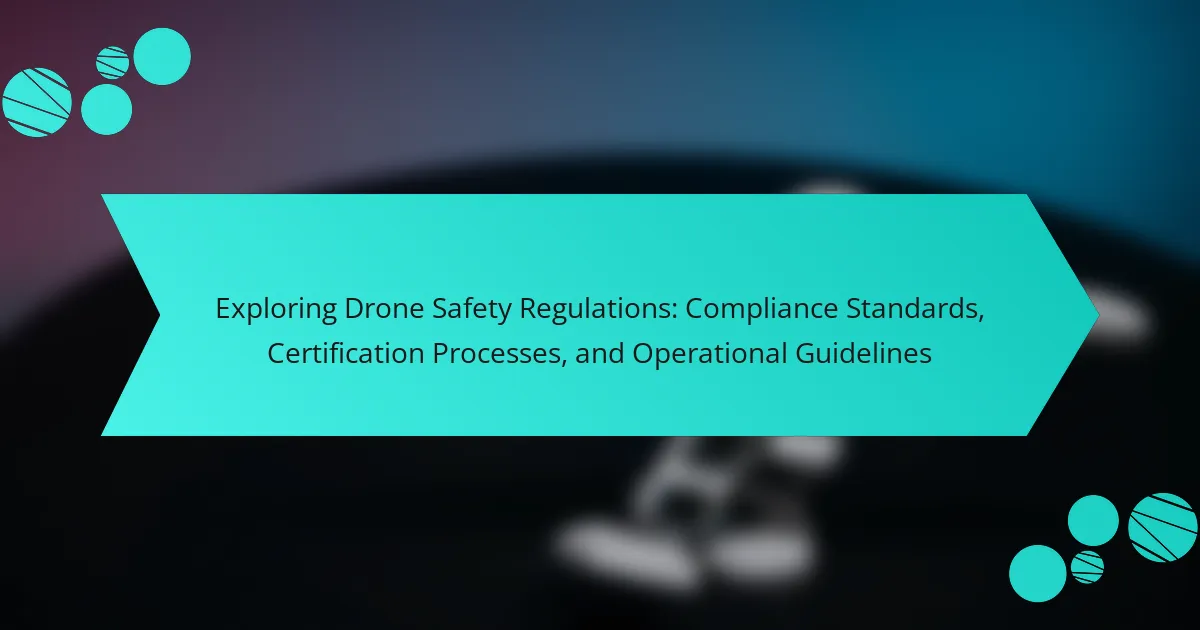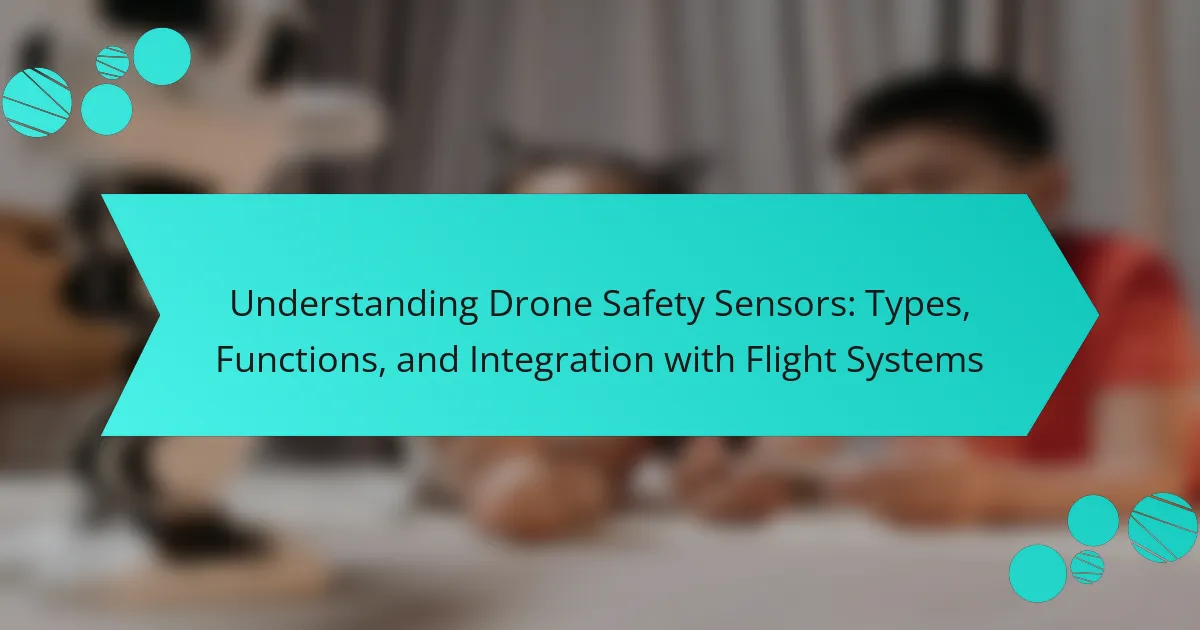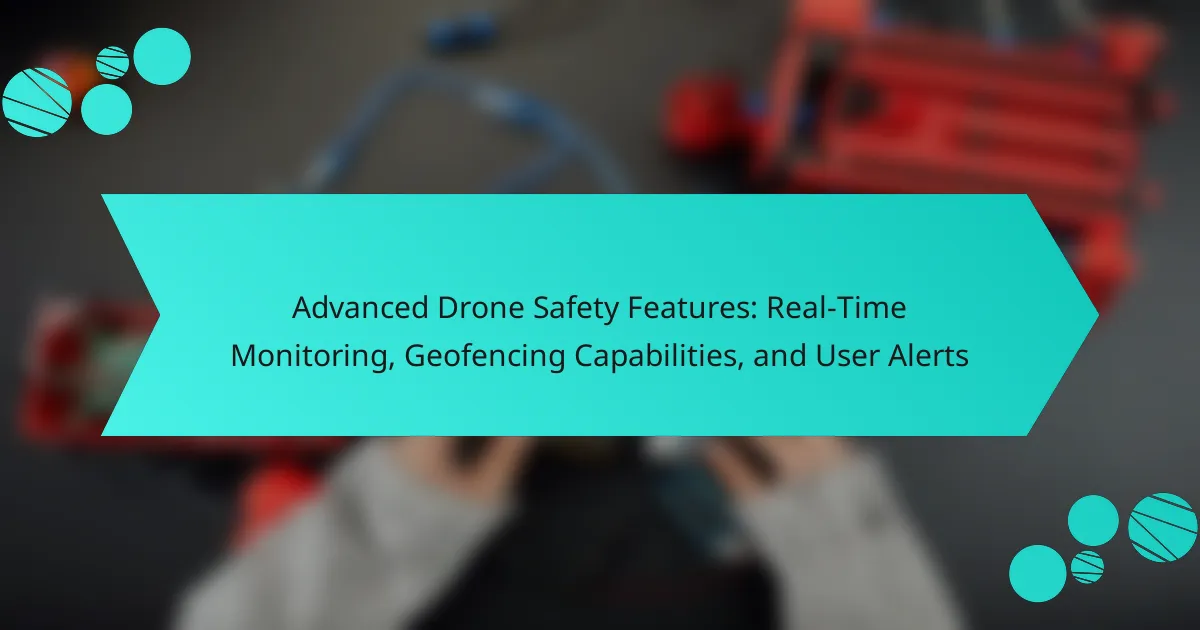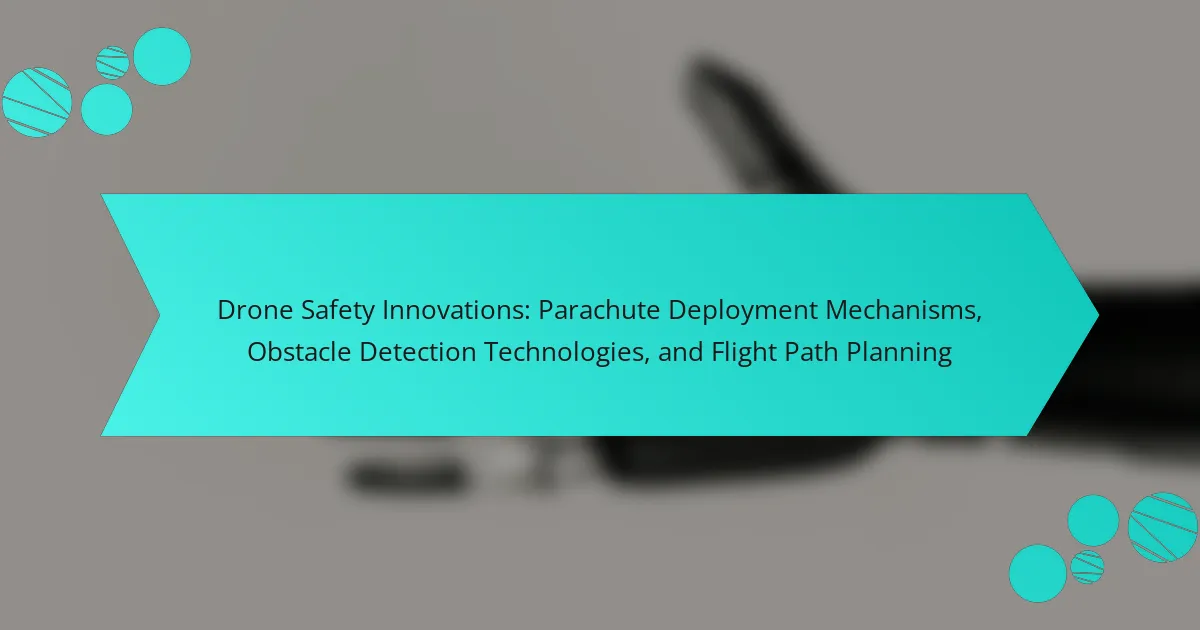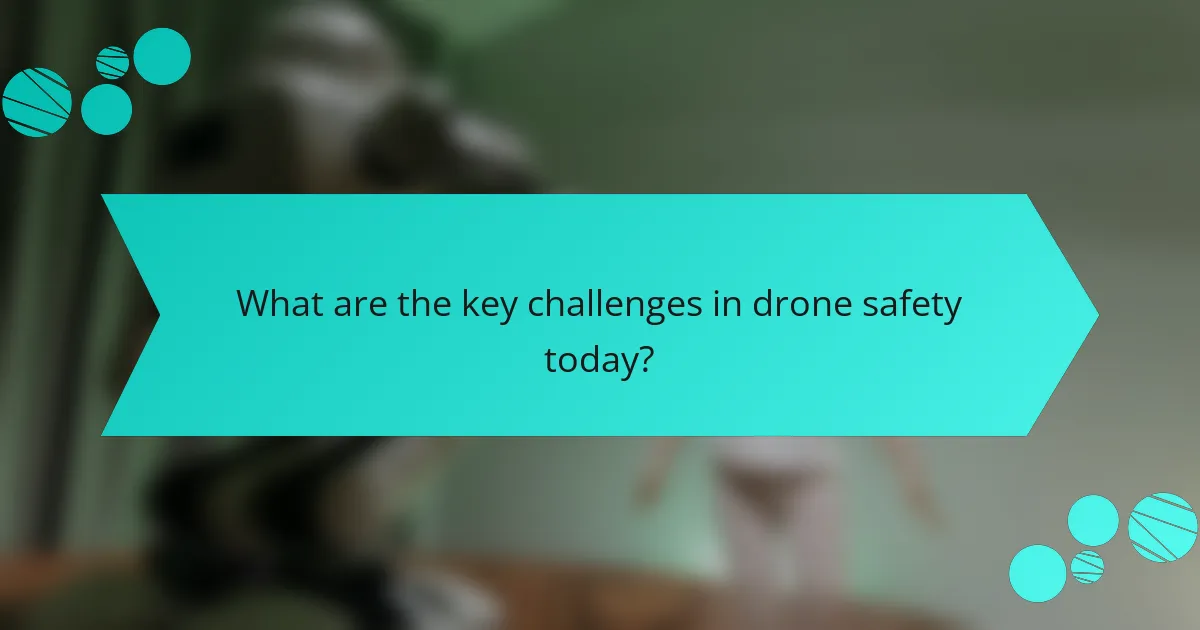
What are the key challenges in drone safety today?
Key challenges in drone safety today include regulatory compliance, airspace congestion, and technological limitations. Regulatory compliance involves navigating complex local and international laws. In 2021, the FAA proposed new rules for remote identification to enhance accountability. Airspace congestion is increasing due to the growing number of drones. The FAA reported a projected increase of 1.5 million drones by 2025. Technological limitations include issues with collision avoidance systems. Current systems may not detect all obstacles effectively. Additionally, cybersecurity threats pose risks to drone operations. A 2020 report highlighted vulnerabilities in drone software that could be exploited. These challenges require ongoing attention to ensure safe drone operations.
How do current technological limitations impact drone safety?
Current technological limitations significantly impact drone safety by restricting operational capabilities. Limited battery life reduces flight duration and increases the risk of mid-air failures. Inadequate obstacle detection systems can lead to collisions with buildings, trees, or other aircraft. Weak communication systems may result in loss of control or inability to receive critical updates. Insufficient data processing power limits the ability to analyze real-time environmental conditions. Additionally, current regulations often lag behind technological advancements, creating gaps in safety protocols. These factors collectively heighten the risk of accidents and impede the safe integration of drones into airspace.
What specific technologies are currently being developed to enhance safety?
Current technologies being developed to enhance safety in drone operations include advanced collision avoidance systems, real-time monitoring software, and automated emergency landing protocols. Collision avoidance systems utilize sensors and machine learning to detect obstacles in real-time. This technology significantly reduces the risk of mid-air collisions. Real-time monitoring software enables operators to track drone performance and environmental conditions continuously. This information helps in making informed decisions during flight. Automated emergency landing protocols are designed to guide drones safely to the ground in case of technical failures. These protocols enhance the reliability of drone operations. Additionally, geofencing technology restricts drones from entering prohibited areas, further ensuring safety. These advancements are crucial for the integration of drones into crowded airspaces.
How do these technologies address existing safety concerns?
Emerging drone technologies address existing safety concerns by enhancing collision avoidance and improving real-time monitoring. Advanced sensors and algorithms allow drones to detect obstacles and adjust their flight paths accordingly. For instance, systems like Automatic Dependent Surveillance-Broadcast (ADS-B) provide situational awareness to avoid mid-air collisions. Additionally, geofencing technology prevents drones from entering restricted airspace, reducing risks of accidents. Data from the Federal Aviation Administration (FAA) indicates that these technologies have significantly decreased incident rates in urban environments. Overall, these innovations contribute to safer drone operations and better compliance with industry regulations.
What role do industry standards play in enhancing drone safety?
Industry standards play a crucial role in enhancing drone safety. They establish guidelines for design, manufacturing, and operation. These standards ensure that drones meet safety requirements before entering the market. For example, the ASTM International F38 committee develops standards for unmanned aircraft systems. Compliance with these standards reduces risks associated with drone operations. They also facilitate interoperability between different drone systems. This interoperability minimizes accidents caused by communication failures. Furthermore, industry standards promote best practices among operators. Adhering to these practices leads to safer flying environments. Overall, industry standards are essential for maintaining high safety levels in drone operations.
Which organizations are responsible for establishing these standards?
The organizations responsible for establishing drone safety standards include the Federal Aviation Administration (FAA) in the United States and the European Union Aviation Safety Agency (EASA) in Europe. The FAA sets regulations for drone operations, ensuring safety in U.S. airspace. EASA develops safety and environmental standards for drone use across EU member states. Both organizations collaborate with industry stakeholders to create comprehensive guidelines. Their standards are essential for integrating drones into national and international airspace safely.
How do industry standards vary across different regions?
Industry standards for drones vary significantly across different regions. In the United States, the Federal Aviation Administration (FAA) regulates drone operations, emphasizing safety and airspace integration. In contrast, the European Union implements the European Union Aviation Safety Agency (EASA) regulations, which focus on harmonizing standards across member states.
Asia presents a diverse landscape; for instance, countries like Japan have stringent regulations for commercial drones, while others like India are still developing their frameworks. Additionally, some regions prioritize innovation, leading to more flexible regulations to encourage technological advancement.
The differences in regulations are influenced by local safety concerns, technological readiness, and economic priorities. Countries may also have unique certification processes for drone manufacturers and operators. These variations reflect the global effort to balance safety, innovation, and economic growth in the drone industry.
What are the global regulations governing drone operations?
Global regulations governing drone operations vary by country and region. The International Civil Aviation Organization (ICAO) provides a framework for member states. Many countries have adopted regulations based on ICAO guidelines. The Federal Aviation Administration (FAA) regulates drone use in the United States. The European Union Aviation Safety Agency (EASA) oversees drone operations in Europe. Regulations often include restrictions on altitude, no-fly zones, and operator licensing. Compliance with these regulations is essential for safe drone operations. Countries continuously update their regulations to address technological advancements and safety concerns.
How do these regulations differ from one country to another?
Drone regulations vary significantly between countries. Each nation establishes its own rules based on safety, privacy, and airspace management. For example, the United States mandates remote identification for drones, while many European countries emphasize strict privacy laws. In Canada, drone operators must complete a certification process, which differs from regulations in Australia that focus on operational limits and airspace restrictions. Additionally, some countries have no formal regulations yet, allowing unrestricted drone use. These differences stem from varying national priorities, technological adoption rates, and public safety concerns.
What are the implications of non-compliance with drone regulations?
Non-compliance with drone regulations can lead to severe legal consequences. Violators may face fines that can reach thousands of dollars. In some cases, criminal charges may be filed against individuals or companies. Additionally, non-compliance can result in the suspension or revocation of drone licenses. This limits future operational capabilities and business opportunities. Safety risks also increase, potentially leading to accidents or injuries. Furthermore, public trust in drone technology may diminish due to irresponsible use. Compliance with regulations is crucial for ensuring safe and responsible drone operations.
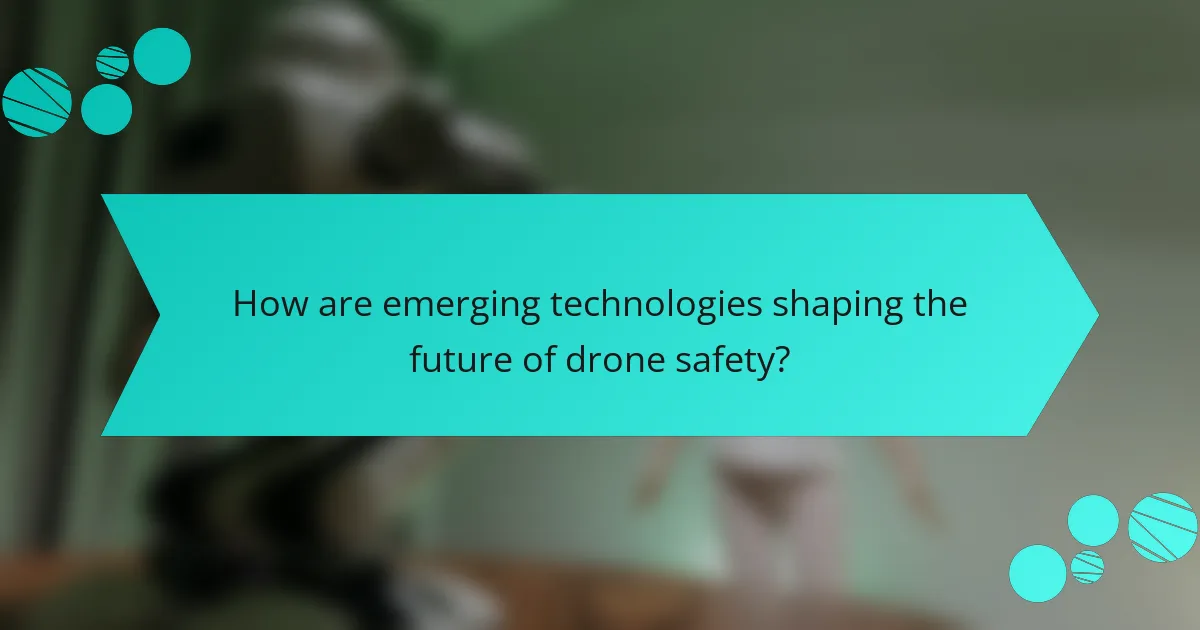
How are emerging technologies shaping the future of drone safety?
Emerging technologies are significantly enhancing drone safety. Advanced sensors improve obstacle detection and collision avoidance. Artificial intelligence algorithms enable real-time decision-making during flight. Enhanced communication systems provide better data exchange between drones and ground control. Blockchain technology ensures secure data transmission and operational transparency. Regulatory bodies are adopting these technologies to establish new safety standards. For instance, the FAA is integrating remote identification systems to track drone activity. These advancements collectively reduce accidents and improve operational reliability in the drone industry.
What innovative safety features are being integrated into drone designs?
Innovative safety features being integrated into drone designs include advanced collision avoidance systems, emergency landing protocols, and real-time monitoring technologies. Collision avoidance systems utilize sensors and algorithms to detect obstacles and navigate around them. Emergency landing protocols ensure safe descent in case of system failures. Real-time monitoring technologies track drone health and location, allowing for immediate response to issues. These features enhance operational safety and reduce risks of accidents. According to the Federal Aviation Administration (FAA), such technologies are essential for the safe integration of drones into national airspace systems.
How do collision avoidance systems improve safety?
Collision avoidance systems significantly enhance safety by preventing accidents between drones and obstacles. These systems utilize sensors and algorithms to detect potential collisions in real-time. By analyzing the drone’s surroundings, they can identify other aircraft, buildings, and terrain features. When a potential collision is detected, the system automatically adjusts the drone’s flight path or alerts the operator. Studies have shown that collision avoidance systems can reduce accident rates by up to 50%. This technology is crucial for safe drone operations, especially in crowded urban environments.
What advancements are being made in drone communication systems?
Advancements in drone communication systems include the development of 5G technology. This technology enhances data transmission speed and reduces latency. Improved communication protocols are also being implemented for better reliability. These protocols facilitate secure and efficient data exchange between drones and ground control. The integration of artificial intelligence is optimizing communication networks. AI algorithms help in managing bandwidth and improving signal strength. Research indicates that these advancements increase the operational range of drones. Enhanced communication capabilities contribute to safer and more efficient drone operations in various industries.
How is artificial intelligence influencing drone safety protocols?
Artificial intelligence is significantly enhancing drone safety protocols. AI algorithms analyze real-time data to identify potential hazards. These systems can predict and prevent collisions with other aircraft or obstacles. AI also improves navigation accuracy through advanced sensor integration. Machine learning models adapt to changing environments, increasing operational safety. Research shows that AI-driven systems reduce human error, a major cause of drone accidents. For instance, a study by the Federal Aviation Administration (FAA) highlights a 30% decrease in incidents when AI is implemented. Overall, AI’s influence is critical in shaping safer drone operations.
What are the potential benefits of AI in real-time decision making for drones?
AI enhances real-time decision making for drones by improving operational efficiency and safety. It enables drones to process vast amounts of data quickly. This capability allows for immediate responses to changing environmental conditions. For instance, AI can analyze weather patterns and avoid hazardous areas. Additionally, AI algorithms can optimize flight paths in real-time, reducing fuel consumption. Enhanced object recognition improves collision avoidance, making flights safer. Studies indicate that AI-driven drones can reduce accident rates by up to 30%. Overall, AI integration significantly boosts the reliability and functionality of drone operations.
What challenges does AI face in maintaining drone safety?
AI faces several challenges in maintaining drone safety. One major challenge is the need for real-time decision-making. Drones must respond quickly to dynamic environments. AI systems can struggle with processing vast amounts of data instantaneously. Another challenge is obstacle detection and avoidance. Drones often operate in complex airspaces with various obstacles. AI must accurately identify and navigate these obstacles to prevent collisions.
Additionally, regulatory compliance presents a challenge. Different regions have varying regulations for drone operations. AI systems must adapt to these regulations to ensure safety. The lack of standardized protocols complicates AI implementation across different jurisdictions. Furthermore, cybersecurity is a significant concern. Drones are vulnerable to hacking and interference. AI must include robust security measures to protect against these threats.
Lastly, the ethical implications of AI decision-making pose challenges. AI may need to make decisions that affect human safety. Ensuring that these decisions align with ethical standards is critical. Overall, AI technology must overcome these hurdles to enhance drone safety effectively.
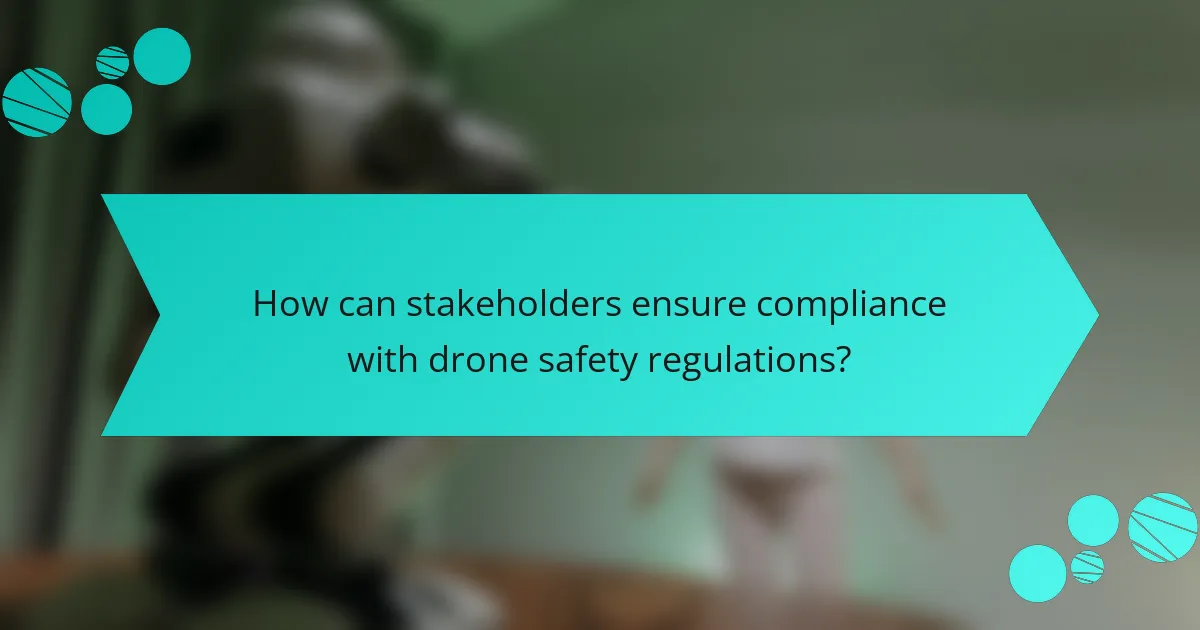
How can stakeholders ensure compliance with drone safety regulations?
Stakeholders can ensure compliance with drone safety regulations by implementing robust training programs. These programs should educate operators on current regulations and safe flying practices. Regular audits and inspections of drone operations can help identify compliance gaps. Stakeholders must also keep abreast of changes in regulations to adapt quickly. Collaboration with regulatory bodies fosters a better understanding of compliance requirements. Utilizing technology such as geo-fencing aids in maintaining operational boundaries. Data collection on flight operations can provide insights into adherence to regulations. Engaging in community outreach enhances public awareness of drone safety.
What best practices should operators follow to enhance safety?
Operators should implement comprehensive safety protocols to enhance drone safety. Regular maintenance checks are essential to ensure equipment reliability. Operators must also conduct thorough pre-flight inspections to identify potential issues. Training programs for pilots should emphasize safety procedures and emergency response. Utilizing real-time data analytics can help monitor drone performance and predict failures. Adhering to local regulations and industry standards is critical for compliance and safety. Implementing a safety management system can systematically address risks and improve safety culture. These practices collectively contribute to reducing accidents and enhancing operational safety.
How can regular maintenance contribute to drone safety?
Regular maintenance significantly enhances drone safety. It ensures that all components function properly and reduces the risk of malfunctions. Routine checks can identify wear and tear before it leads to failure. For instance, inspecting propellers can prevent accidents caused by blade damage. Additionally, maintaining battery health is crucial, as degraded batteries can lead to power loss during flight. A study by the Federal Aviation Administration (FAA) indicates that regular maintenance can decrease crash rates by up to 30%. This highlights the importance of adhering to maintenance schedules for safe drone operation.
What training programs are available for drone operators?
Various training programs are available for drone operators. These programs include online courses, in-person classes, and certification programs. Organizations like the Federal Aviation Administration (FAA) offer Part 107 certification training. This training covers regulations, airspace classification, and safety procedures. Many universities and colleges also provide drone pilot training programs. These programs often include hands-on flight experience and technical instruction. Additionally, private companies offer specialized courses for commercial drone applications. These courses focus on specific industries like agriculture, construction, and filmmaking. Each of these programs aims to ensure operators are knowledgeable and compliant with safety standards.
What future trends should we expect in drone safety regulations and technologies?
Future trends in drone safety regulations and technologies include enhanced air traffic management systems and more stringent compliance measures. Regulatory bodies are likely to adopt remote identification requirements for drones. This will improve accountability and tracking capabilities. Advanced technologies such as AI and machine learning will be integrated into safety systems. These technologies can predict and prevent potential hazards. Additionally, there will be a focus on developing fail-safe mechanisms for drones. This aims to minimize risks during operations. Collaboration between governments and industry stakeholders will also increase. This will ensure that regulations keep pace with technological advancements. The implementation of these trends is expected to enhance overall safety in drone operations.
How might international cooperation influence global drone safety standards?
International cooperation can significantly enhance global drone safety standards. By collaborating, countries can establish unified regulations that promote safety and efficiency. Shared data on incidents and best practices can lead to better risk assessments. Joint training programs can improve operator skills across borders. Collaborative research can drive technological advancements in drone safety features. For example, the International Civil Aviation Organization (ICAO) encourages member states to harmonize regulations. This approach can lead to a more standardized framework for drone operations worldwide. Enhanced safety standards can ultimately reduce accidents and increase public trust in drone technology.
What role will public perception play in shaping future regulations?
Public perception will significantly influence future regulations on drone safety. Regulatory bodies often consider public opinion when drafting policies. For instance, concerns about privacy and safety can lead to stricter regulations. Research indicates that public support is crucial for the acceptance of new technologies. A survey by the Federal Aviation Administration found that 60% of respondents expressed safety concerns regarding drones. As public awareness increases, regulators may adapt rules to address these issues. Ultimately, public perception acts as a feedback mechanism that shapes regulatory frameworks.
What practical steps can individuals take to promote drone safety?
Individuals can promote drone safety by adhering to established regulations. They should familiarize themselves with local drone laws and guidelines. This includes understanding no-fly zones and altitude restrictions. Regular maintenance of drones is essential for safe operation. Individuals should also conduct pre-flight checks to ensure all systems function properly. Staying updated on drone technology advancements can enhance safety practices. Participating in community safety workshops encourages shared knowledge and best practices. Lastly, reporting unsafe drone activities helps authorities address potential risks effectively.
The main entity of the article is drone safety, focusing on emerging technologies, industry standards, and global regulations. Key challenges in drone safety today include regulatory compliance, airspace congestion, and technological limitations, which impact operational capabilities and increase risks. The article discusses advancements such as collision avoidance systems, real-time monitoring software, and automated emergency protocols that enhance safety. It also highlights the role of industry standards in ensuring safe drone operations and the variations in regulations across different regions. Finally, the article examines how stakeholders can promote compliance and the future trends expected in drone safety regulations and technologies.
